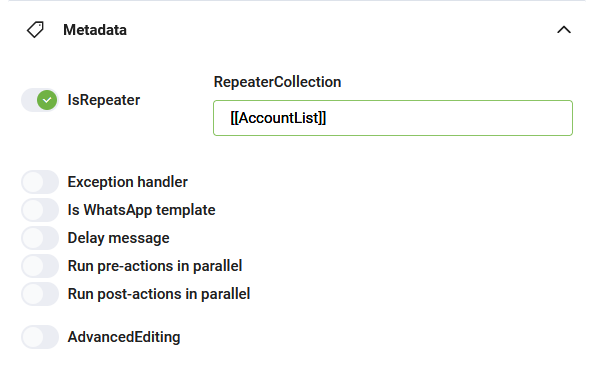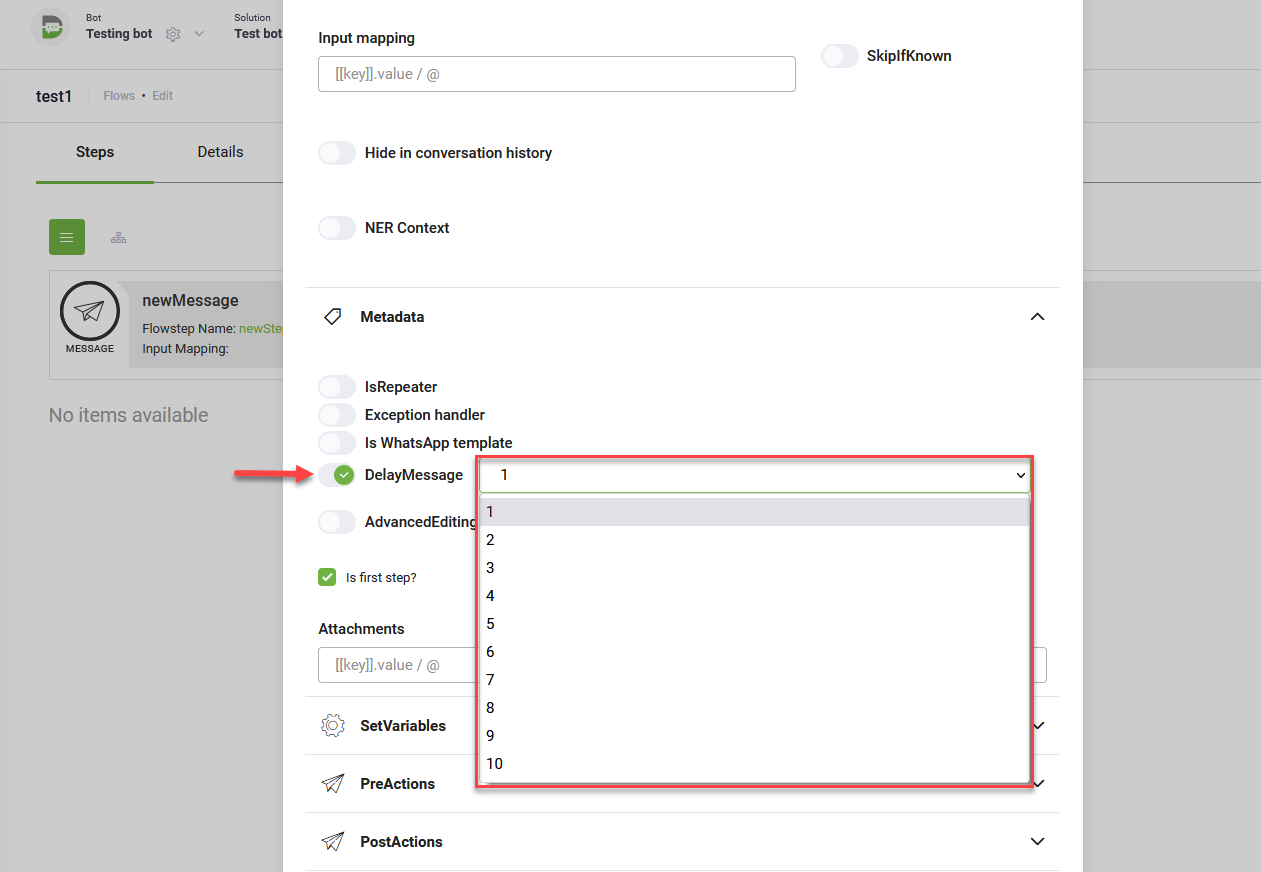Metadata
To access the flow step metadata, in the Flow Step editor, click on the Metadata section header. The section expands. The settings available in this section depend on the flow step type.
The table below describes the parameters available in the Metadata section.
| Parameter | Description |
|---|---|
| Is repeater | Tap on if you want to show dynamic elements within the chat conversation based on an entity list and in the Repeater collection field enter the name of the entity list: [[<Entity list>]] or [[<Entity>]].<EntityListField>. For example, if you want to display the list of accounts, tap on Is repeater and enter the name of the entity collection [[AccountList]].
By default, a card with Is repeater generates one card for each item in the provided collection. You have an advanced option to generate one card with as many buttons as items are in a collection. You can configure a card with multiple buttons for the following step types: Hero, Thumbnail or Choice. |
| Block user input | Prevents users from typing in the chat and forces them to make a selection by clicking a button or making a selection. This option is available for Hero card steps, Adaptive cards, and Choice steps. |
| Exception handler | Tap on if you want the flow to continue when connector action errors occur. If you have more PreActions and PostActions defined on the step and an error occur on one of the preActions, neither the subsequent PreActions or PostActions are executed. The error is logged in the [[SystemError]] entity and has two fields: [[SystemError]].CorrelationId and [[SystemError]].Message.
NOTE: If errors occur on multiple steps during a flow execution, the system overwrites the errors, so when using Exception handler, you might want to evaluate the [[SystemError]] entity after each step execution. IMPORTANT! For steps with input mapping you can set the number of attempts and configure the way you want to handle exceptions on the step. For more information, see Exception Handling on Flow Steps with Input Mapping. |
| Is WhatsApp template | Tap on if you want to proactively send notifications to customers (e.g., confirm doctor appointment) via the WhatsApp channel. For more information on WhatsApp Message Templates, see WhatsApp Message Templates. |
| Delay message | Adds a delay inside the step, between pre-action and the step message; delays the message and everything that comes after (post-actions). To activate it, tap on the option and select the desired value of the delay, between 1 and 10 seconds. If the user writes something in the chat during the delay period set on the flow step, then the bot will answer with the special message WaitForConnectorActionComplete. |
| Run pre-actions in parallel |
IMPORTANT!
When executing many integrations on a flow step before sending a message to the user in the chat and you want to improve the response time of your chatbot, tap on one or both settings (as best suits your needs) and DRUID will run in parallel the integrations on the flow step.
NOTE: Only the integration set on the flow step are run in parallel; the connector tasks from a connector action are run sequentially. IMPORTANT! Use the two settings wisely! The entity fields and local variables used in an integration use the same execution context within the connector action; therefore, make sure that they are unique per integration / connector action; otherwise, their values might be overwritten and the results of the integrations might not be accurate or missing.
If one or more integrations return error, the rest of integrations on the step will be executed and the overall flow step will be treated as connector error and the conversation will be interrupted or if Exception handler is set on the step, the error will be ignored and DRUID will execute the next flow step.
|
| Run post-actions in parallel | |
| Inactivate card after usage |
Prevents users from clicking the card multiple times or resubmitting field values. This option is available only with Bot Framework v4 and applies to Hero card steps and Adaptive cards on the Direct Line (web) channel. |
| Advanced Editing | Displays the current step in JSON format. |
| Is first step? | Tick to set the current step as the flow’s first step. |
Rendering Dynamic Content
You can render dynamic content on steps to return a list and complete the data structure which will be stored in an Entity List.
To render dynamic content, go to the step configuration page, click the Metadata section header. The section expands. Tap on Is repeater and in the Repeater collection field enter the entity collection which will store the data structure.
Click the Save button at the bottom of the page to save the changes.

